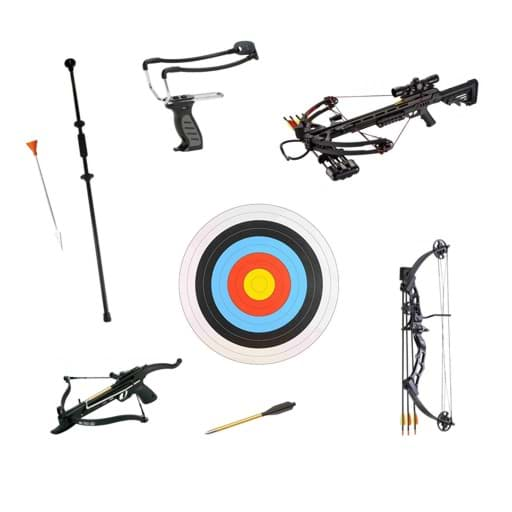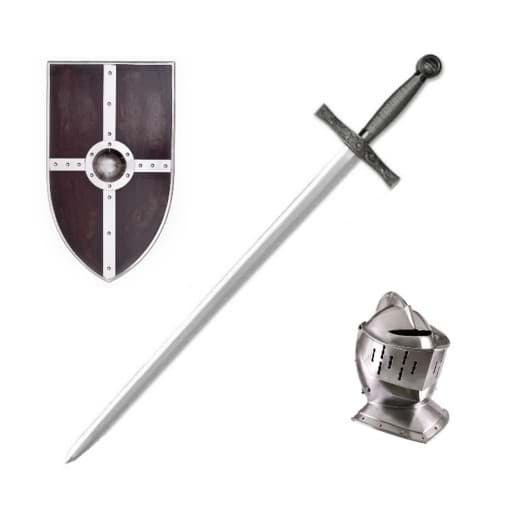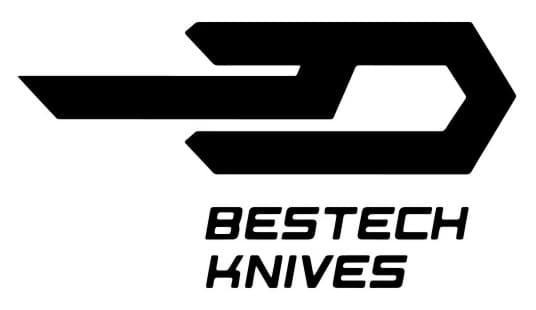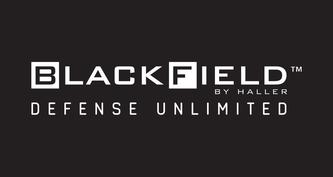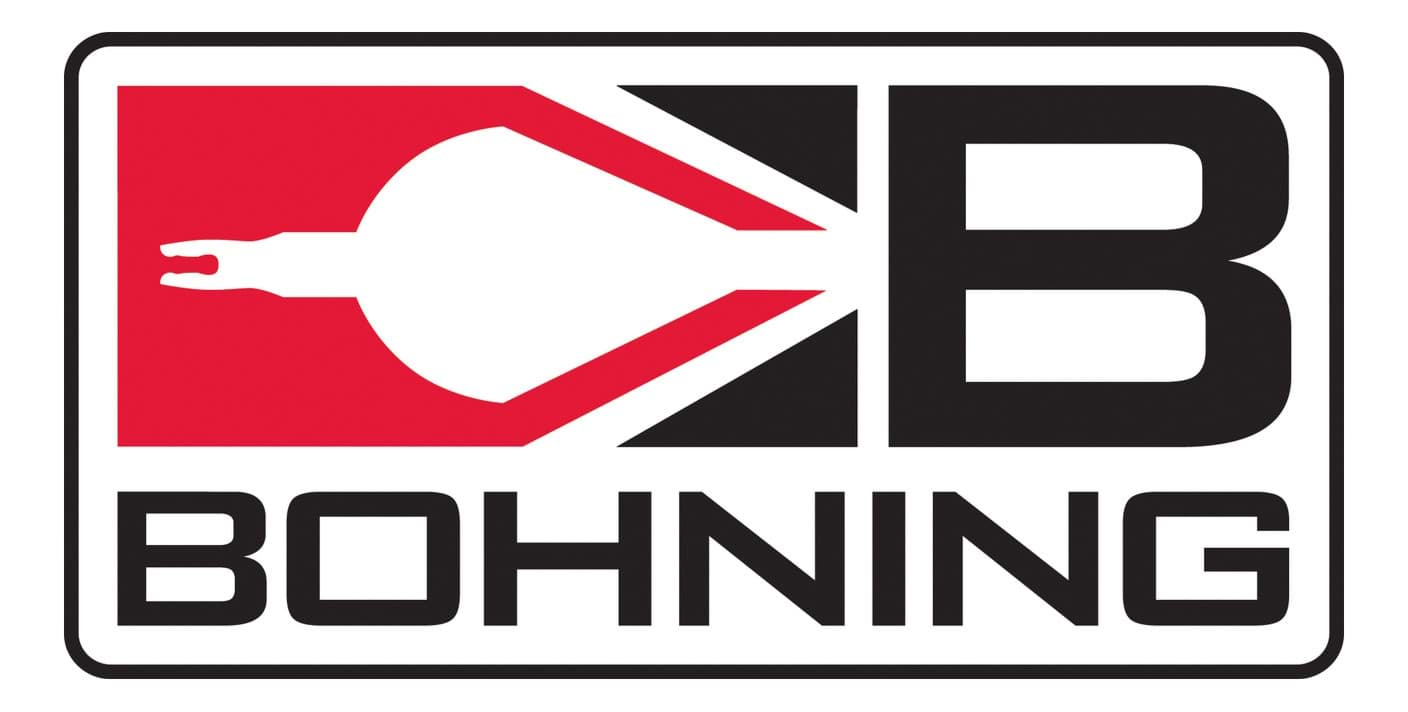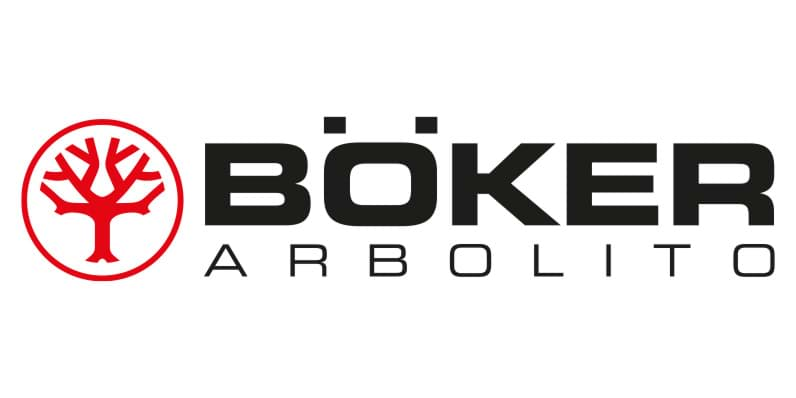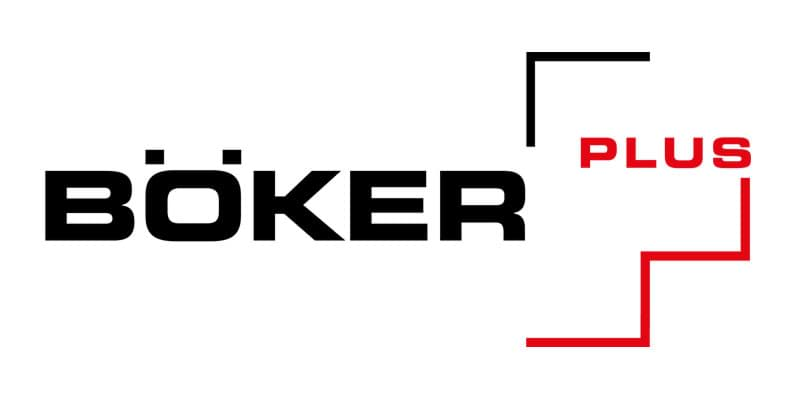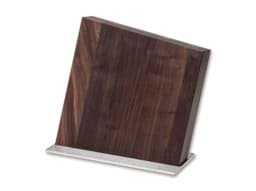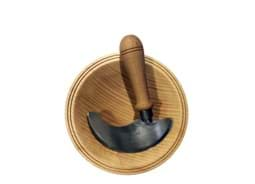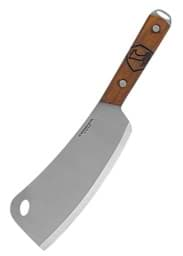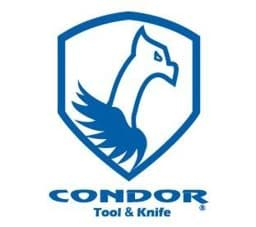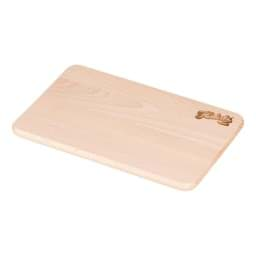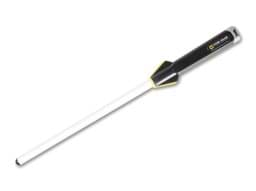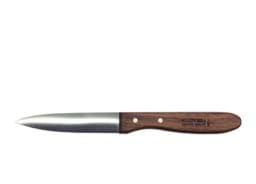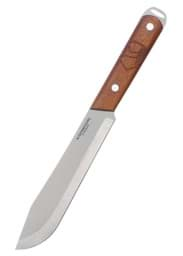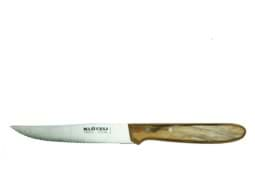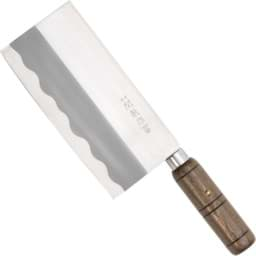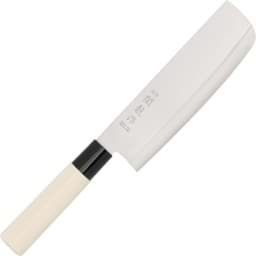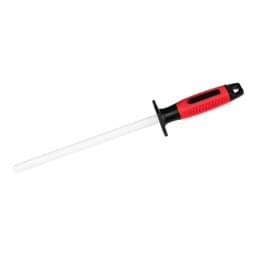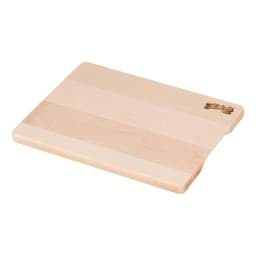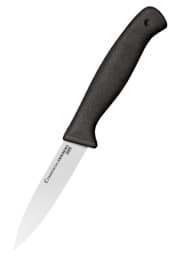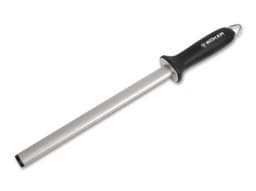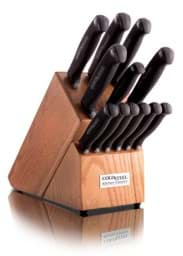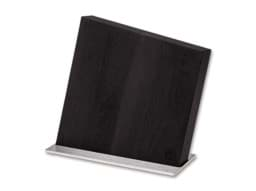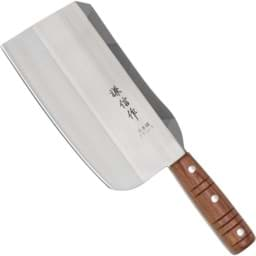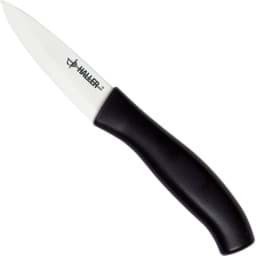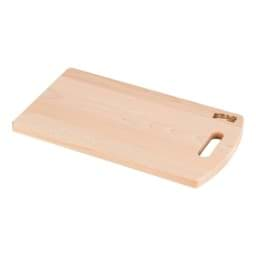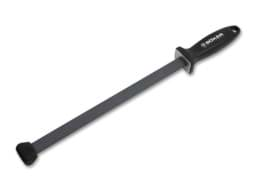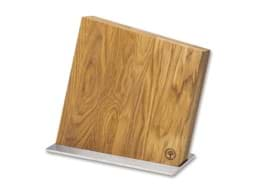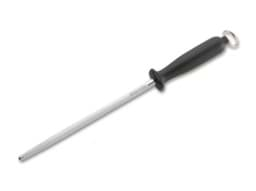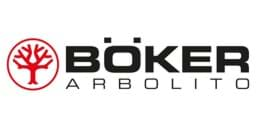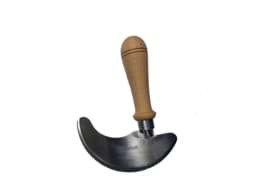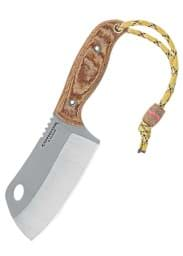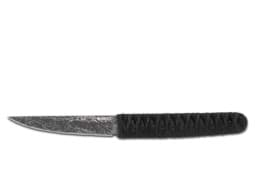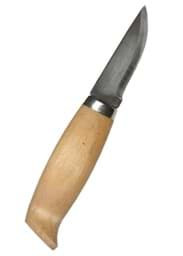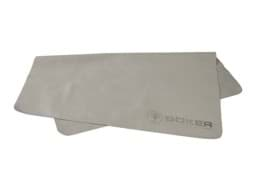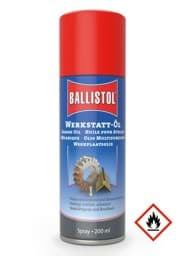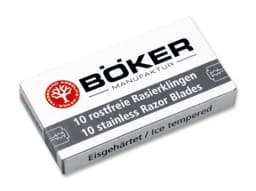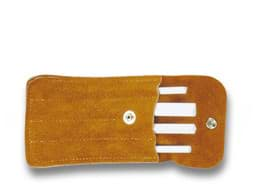Kitchen knives are undoubtedly part of the basic equipment of every professional chef. Also in your own kitchen, a knife that cuts reliably proves to be a great help. However, anyone who wants to buy a kitchen knife quickly realizes that the trade offers various designs. The individual models differ both in terms of their shape and size, as well as in terms of the materials used.
At Meister Messer, you will find not only a wide selection of high-quality kitchen knives. You will also learn about the criteria you should pay attention to in order to find the ideal knife.
What types of kitchen knives are there?
The different types of knives can be distinguished by their intended use. On the one hand, there are all-rounders and on the other hand, specialty knives that are predestined for specific tasks. Among the models that you can use universally are chef's knives, Santoku knives, and utility knives:
- The Chef's knife is one of the most important utensils in any kitchen. It has a blade that is approximately 20 to 25 centimeters long, pointed, and a relatively high back. This type of knife is suitable for processing both meat and fish, as well as chopping vegetables and chopping herbs.
- Santoku knives are the Japanese equivalent of the classic chef's knife. Compared to numerous other Japanese kitchen knives, the versatile Santoku knives are characterized by their double-edged blade. These models often also feature so-called grantons. These are regularly distributed hollows in the blade that reduce friction on the food being cut. By the way, the term "Santoku" translates to "Three Virtues" and can be understood as a reference to the functionality of the knives (meat, fish, and vegetables).
- The Allzweckmesser is also known as an office or paring knife. It is a slightly more manageable version of a regular chef's knife. The blade is slightly shorter and narrower, allowing for high precision cutting. Therefore, Allzweckmesser are particularly suitable for smaller items such as fruit, vegetables, and smaller pieces of meat.
In addition to the chef's knives, there are also a whole range of knife types designed for specific tasks. This category includes the following types of kitchen knives:
- A bread knife is characterized by a long serrated blade that allows you to cut through tough bread crusts without crushing the interior. However, the serrated blade is not only suitable for bread and rolls, but also works well for other foods - for example, for dividing lettuce heads and cutting tomatoes.
- A paring knife is a handy kitchen knife with a blade approximately 6 to 10 centimeters long. It is mainly used for peeling or cutting fruits and vegetables, but is also suitable for numerous other tasks requiring precision.
- Carving knife is a generic term for various types of knives. A filleting knife allows you to cut meat into very thin slices. With a boning knife, you can expertly break down larger pieces of meat. On the other hand, a carving knife is recommended for carving a roast at the dining table.
- Cheese knives are available in different designs tailored to the consistency and texture of the cheese. A knife for soft cheese typically has indentations in the blade. These prevent cheese from sticking to the knife while cutting. For hard cheese, on the other hand, slicing knives with a narrow and sturdy blade are recommended. Additionally, specialized knives for blue cheese and other specific types of cheese are also available in the market.
- Cleavers are extremely sharp and primarily designed to chop large pieces of meat and bones. You can also use these hefty knives to prepare vegetables and chop herbs. While versions used in the meat industry can have a blade length of up to 40 centimeters, those designed for household use have a significantly shorter length, with a maximum of 20 centimeters.
Which kitchen knives should a chef be equipped with?
This question cannot be answered in a general way, as various aspects play a role here. One central aspect is how often you cook. On the other hand, it depends on which dishes you want to prepare. For example, those who eat vegetarian or vegan usually do not need special meat knives.
In most households, three to five kitchen knives are used. Even beginners should have at least one chef's knife, a utility knife, and a bread knife. Additionally, it is recommended to also have a multipurpose knife in the kitchen.
If you don't have much experience in cooking yet, generally speaking, universally applicable kitchen knives are more suitable. Whether it makes sense to acquire additional types of knives depends on the specific case. For example, if you often serve cheese to guests, it is worth purchasing a corresponding knife. However, in general, it is recommended for inexperienced chefs to refrain from using specialized knives for the time being. Also, the often one-sided sharpened kitchen knives from Japan are more suitable for professionals.
Buy kitchen knives: The most famous brands - our top 5
If you want to get new kitchen knives, you can choose from numerous brands. Each manufacturer contributes its own history and craftsmanship, which is reflected in the quality and performance of the knives. Below we introduce you to five renowned knife brands that have made a name for themselves with their outstanding quality and unique design:
- Böker: The German traditional brand can look back on a company history of more than 150 years. Böker kitchen knives stand for high-quality materials and are crafted with meticulous precision. The knife manufacturer combines functionality with elegance in its products, making them a favorite among connoisseurs. In addition to kitchen knives, Böker's product range also includes pocket and outdoor knives.
- Samura: The knife brand originally from Japan brings the art of Japanese knife forging into your kitchen. Samura combines traditional manufacturing methods with innovative technology and is particularly known for its razor-sharp blades and ergonomically designed handles. Samura knives enable very precise work and at the same time offer high comfort during use.
- Cold Steel: Cold Steel is an American manufacturer that scores with unique quality standards. The company is especially famous for its extremely robust hunting, survival, and combat knives, but also offers kitchen knives. These were also designed for the highest demands and are characterized by long durability.
- Due Cigni: The Italian knife brand represents the elegance and finesse of Italian craftsmanship. Due Cigni produces a variety of cutting tools for the kitchen, ranging from chef's knives to paring knives to steak knives, always impressing with an excellent balance between sharpness and handling. The kitchen knives from Due Cigni are a testament to Italian design art, paired with functional perfection.
- Odenwolf: The up-and-coming brand Odenwolf has quickly made a name for itself with high-quality kitchen knives at affordable prices. The products of the manufacturer are ideal for daily use and offer an excellent mix of innovative design, durability, and cutting performance.
What criteria are important when buying a kitchen knife?
Before you start searching for the right model, you need to think about what purpose the kitchen knife is intended for. This aspect determines which type of knife is most suitable for you. For example, if you are looking for a knife that can be used for both meat and vegetables, a chef's or utility knife is a good choice.
No matter what type of kitchen knife you want to buy, this is not the only important criterion. There are other factors that can be found in almost every kitchen knife test and should therefore be taken into account by you.
Blade material
For knife blades, a wide variety of steel types are used. The material hardness of steel and other technical materials is usually specified in "Rockwell hardness" – abbreviated as HRC. Generally speaking: The higher the carbon content of the steel, the harder the blade and the longer it retains its sharpness. Japanese kitchen knives made of Damascus steel are considered unbeatable in this context.
However, nowadays it is possible to produce blades from a single piece of very hard high-performance steel, which are in no way inferior to the Damascus blades. However, models made of slightly softer steel have better corrosion resistance, making them easier to maintain.
With ceramic knives, there is an alternative that also has excellent cutting properties. However, a disadvantage is that the blade can break if the knife falls down once. Also, a ceramic knife is by no means suitable for chopping. Instead, use a cleaver with a steel blade for that purpose.
Production process
A knife blade can either be punched out of a sheet of steel or forged by hand. Punching out is the more cost-effective option. Kitchen knives with a hand-forged blade are mainly found in the high-price segment. Corresponding knife blades have a better density ratio, as a result of which such designs are generally harder and more durable.
Handle material
Different materials are used for the handles as well. While a plastic handle is relatively easy to clean, natural ingredients in wooden knife handles help to kill bacteria. However, wooden handles are particularly popular because of their aesthetics. Metal handles also score points with their high-quality appearance, but heat up quickly when the kitchen knife is near a heat source (for example, on the stove).
Haptik und Balance
How efficiently a chef can work with a kitchen knife also depends on the feel and balance of the tool. On the one hand, the knife must fit well in the hand. Make sure that the knife handle is ergonomically shaped. On the other hand, the center of gravity of the kitchen tool should be between the handle and the blade, as cutting in this case requires the least amount of force.
The weight of the knife is also important. However, opinions on this matter are divided. Some hobby and professional chefs prefer kitchen knives with the lowest possible total weight. Others prefer more solid models, as these often fit particularly well in the hand. In this respect, your personal preferences are particularly important
Single knife or kitchen knife set?
Whether a single kitchen knife or a knife set is more suitable depends primarily on your starting point. Two key questions are particularly important in this context:
- How extensive is your current equipment?
- How often is cooking done in your household at all?
If the most important kitchen knives are already available in your household, you don't necessarily need to buy a set. Such a set is more suitable for individuals who want to acquire a basic set of knives. Good knife sets typically include all types of knives that you need in the kitchen, such as a chef's knife and a utility knife.
Kitchen knife sets consist of up to 15 knives, but even three- or five-piece sets offer you a solid basic equipment. More extensive knife sets are primarily suitable for hobby and professional chefs. In general, the acquisition costs for a set are lower than if you were to buy all kitchen knives individually. In addition, knife sets score points with a uniform design.
Sharpen kitchen knives: This way your knives are always ready for use
Even the best kitchen knives eventually lose their sharpness. To ensure your cutting tools always function optimally, it is necessary to regularly sharpen the knives. A dull kitchen knife requires more force when cutting and increases the risk of injury. Regular sharpening also extends the life of your knives.
To sharpen the blade of a knife, there are various options. Most often, a sharpening steel or a sharpening stone is used, but sometimes also electric knife sharpeners or ceramic sharpeners are used:
- A honing steel is designed for regular use and is ideal for maintaining the sharpness of the knife blade. The knife sharpener realigns the edge without removing much material.
- For a more thorough sharpening, a sharpening stone is recommended. These are available in different grits, ranging from coarse to very fine. Models with a grit size up to 600 are suitable for coarse sharpening, while those with a grit size from 1000 to 3000 are suitable for fine sharpening. Also worth knowing: Japanese kitchen knives should generally be sharpened with a water sharpening stone due to their delicate blade.
- An electric knife sharpener provides a convenient and quick method for sharpening kitchen knives. Such a device is particularly suitable for individuals who do not have much time or experience with manual methods.
- If you are looking for a gentler alternative to the sharpening steel, especially suitable for finer blades, a ceramic sharpener is an excellent choice. It removes very little material and is therefore well suited for regular maintenance. You can also use a ceramic sharpener for Japanese knives, but you will achieve even better results with a water sharpening stone.
You also have the option to have your kitchen knives sharpened by a professional sharpening service. However, this option is only worthwhile from a cost perspective for high-quality cutting tools - such as kitchen knives made of Damascus steel.
The best care tips for kitchen knives
A good kitchen knife is a loyal companion in the world of culinary creations, but it needs to be maintained to ensure its performance and longevity. We will reveal to you below how to keep your cutting tools in top condition using simple yet effective methods:
- Cleaning: Kitchen knives should ideally be cleaned immediately after use to prevent food residues and acids from attacking the blade. Use warm water and a mild detergent. Avoid cleaning the knives in the dishwasher, as aggressive cleaning agents and salts can harm the knife blade. After cleaning, kitchen knives should be dried immediately to prevent rust formation.
- Storage: Knives should always be stored in a dry place. Knife blocks, magnetic strips, and special knife compartments in drawers are considered ideal. These storage methods prevent the blades from hitting each other and getting damaged.
- Cutting board: Use cutting boards made of wood or plastic. These materials are gentler on the blades than hard surfaces like glass or stone, which can dull the knife's sharpness over time. A suitable cutting board absorbs some of the pressure while cutting, thus contributing to the longevity of the blade.
- Regular Maintenance: Regularly check the blades of your knives for damage and sharpen them as needed. Especially with knives made of carbon steel, it is also advisable to occasionally treat the blade with a protective oil to prevent corrosion. If your knife has a wooden handle, a special oil should also be applied regularly to protect and maintain the handle.
Buy high-quality kitchen knives at Meister Messer
Do you need a reliable kitchen knife or want to expand your collection with a new piece? At Meister Messer, you will find the perfect knife for every application. Our range includes not only a large number of chef's and utility knives, but also numerous specialty knives. These can be used, for example, for peeling fruit and vegetables, carving a roast, or arranging a cheese platter. In addition, our selection also includes knife sets and knife blocks as well as various cutting boards.
If you want to get yourself a basic set of kitchen knives, especially models that you can use versatilely - for meat, fish, and vegetables. If you need several knives, you should consider purchasing a kitchen knife set. Apart from the bread knife, the various specialty knives are recommended primarily for professional chefs and active hobby cooks.
But regardless of what type of kitchen knife you are interested in: At Meister Messer you will definitely find what you are looking for - So simply and uncomplicatedly buy a kitchen knife online now.
FAQ - Frequently Asked Questions about "Kitchen Knives"
What do good kitchen knives cost?
High-quality kitchen knives are available in stores - and of course also at Meister Messer - starting from 20 to 40 CHF. However, prices for knives can vary significantly depending on the manufacturing effort and the materials used. Particularly premium kitchen knives - such as Santoku knives made of Damascus steel - can sometimes cost significantly more than 100 Swiss francs.
How to best store kitchen knives?
For the proper storage of kitchen knives, both knife blocks and magnetic strips are suitable. You should definitely avoid simply leaving knives loose in a drawer. On the one hand, the blades constantly bump against each other, causing the kitchen utensils to dull more quickly. On the other hand, there is of course a certain risk of injury. For transportation, special knife cases and bags as well as blade guards are recommended.
Which kitchen knives should be present in every household?
A kitchen knife, a utility knife, and a bread knife are essential tools in every kitchen. The kitchen knife is considered an absolute all-rounder, while a handy utility knife is especially suitable for fruits and vegetables. With the serrated blade of a bread knife, you can not only cut bread and rolls but also, for example, divide lettuce heads. In addition, you should also have a utility knife - a compact version of the kitchen knife - in your collection.
How to sharpen a kitchen knife?
Even the kitchen knives with the highest edge retention will not stay sharp forever. You can either sharpen your knives using a honing steel or use a sharpening stone for that purpose. While honing steels simply realign the worn blade edge, a sharpening stone removes material, renewing the geometry of the edge. This means honing keeps your kitchen knives sharp for longer. Sharpening, on the other hand, re-sharpens your knives.
What care does a kitchen knife need?
To ensure the longevity of a kitchen knife, you should follow some care tips. The most important rule is: Avoid putting knives in the dishwasher and instead clean them by hand. If the knife handle is made of wood, it is advisable to regularly treat it with oil (such as linseed oil) or wax (for example, beeswax). In addition, you should avoid aggressive cleaning agents.
What are the best kitchen knife brands?
Since personal taste plays a major role here, it is difficult to generalize. However, some of the top brands include Böker, Samura, and Tojiro. If you are looking for an affordable knife, you might also consider models from Cold Steel and Odenwolf.

